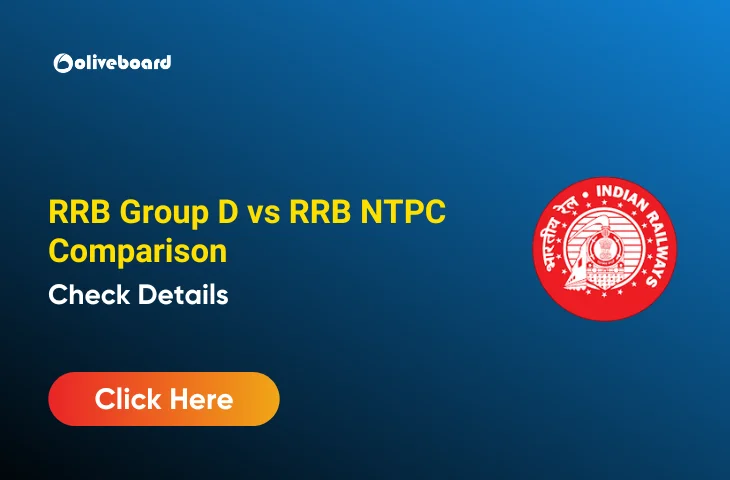The Railway Recruitment Board (RRB) conducts multiple exams to recruit candidates across various posts in Indian Railways. Among these, RRB Group D and RRB NTPC are the most popular and highly sought-after exams. Aspirants often wonder which exam is tougher and why. This article provides an in-depth comparison of these two exams, highlighting the differences in syllabus, difficulty, competition, and preparation strategies.
Overview of RRB Group D and RRB NTPC
RRB Group D and RRB NTPC serve different recruitment purposes and cater to different educational backgrounds. Understanding their structure is the first step in comparing difficulty levels.
| Feature | RRB Group D | RRB NTPC |
| Posts | Track Maintainer, Helper, Assistant Pointsman, etc. | Junior Clerk, Assistant Station Master, Goods Guard, Traffic Assistant, etc. |
| Minimum Qualification | 10th Pass | 12th Pass |
| Exam Level | Basic | Moderate to Advanced |
| Exam Stages | CBT + Physical Efficiency Test (PET) + Document Verification | CBT-1 + CBT-2 + Aptitude Test (for some posts) + Document Verification |
| Total Vacancies | Usually higher (~1.1 Lakh) | Moderate (~35,000 to 40,000) |
RRB Group D vs RRB NTPC Exam Pattern Comparison
A detailed exam pattern comparison has been shown below between RRB Group D vs RRB NTPC. Check out the details:
RRB Group D Exam Pattern
The RRB Group D Exam Pattern for CBT tests candidates on basic general knowledge, mathematics, reasoning, and science.
- Total Questions: 100
- Duration: 90 minutes
- Subjects & Marks Distribution:
| Section | Questions | Marks |
| Mathematics | 25 | 25 |
| General Intelligence & Reasoning | 25 | 25 |
| General Science | 25 | 25 |
| General Awareness | 25 | 25 |
- Negative Marking: 1/3rd mark for wrong answers
Key Observation: Questions are generally straightforward, focusing on 10th standard level concepts.
RRB NTPC Exam Pattern
RRB NTPC Exam Pattern has a two-stage Computer-Based Test (CBT) structure.
CBT-1
- Total Questions: 100
- Duration: 90 minutes
- Sections & Marks:
| Section | Question | Marks |
| Mathematics | 30 | 30 |
| General Intelligence & Reasoning | 30 | 30 |
| General Awareness | 40 | 40 |
CBT-2
- Duration: 90 minutes
- Total Questions: 120
- Sections: In-depth testing of relevant subjects depending on post
- Aptitude Test: Required for specific technical posts
Key Observation: CBT-2 has tougher analytical questions, high competition, and more extensive syllabus compared to Group D.
RRB Group D vs RRB NTPC Syllabus Comparison
The RRB Group D Syllabus varies from the NTPC Syllabus. Given below are the details:
| Subject | RRB Group D | RRB NTPC |
| Mathematics | Basic arithmetic, fractions, percentages, ratio & proportion, averages | Advanced arithmetic, algebra, geometry, data interpretation, ratio & proportion |
| Reasoning | Simple puzzles, analogy, odd-one-out, coding-decoding | Complex puzzles, seating arrangement, blood relations, coding-decoding, inequality |
| General Science | Physics, Chemistry, Biology (10th standard) | Physics, Chemistry, Biology (12th standard level and practical applications) |
| General Awareness | Current Affairs, Indian History, Geography, Polity | Current Affairs, Economy, Budget, Railway Awareness, International Events |
Observation: NTPC requires a higher level of understanding, especially in Mathematics and General Awareness.
RRB Group D vs RRB NTPC Eligibility Criteria Comparison
The table below shows the RRB Group D vs RRB NTPC eligibility criteria comparison for the applicants:
| Aspect | RRB NTPC | RRB Group D |
| Educational Qualification | Minimum: 12th Pass (Intermediate) or equivalent from a recognized board. | Minimum: 10th Pass (Matriculation) or ITI from a recognized board/institute. |
| Age Limit (General Category) | 18–33 years (varies slightly by post). | 18–33 years (varies slightly by post). |
| Age Relaxation | SC/ST: +5 years; OBC: +3 years; Ex-Servicemen, PwBD: as per rules. | SC/ST: +5 years; OBC: +3 years; Ex-Servicemen, PwBD: as per rules. |
| Physical Standards | No strict physical standards; mainly for clerical and commercial posts. | Strict physical standards required for physically demanding posts (e.g., Track Maintainer, Helper). |
| Medical Standards | Medical exam is required, but less stringent compared to Group D. | Medical exam is stricter due to physical nature of work; vision, hearing, and endurance tested. |
| Skill/Typing Test | For certain posts (like Junior Clerk, Typist) – typing/skill test mandatory. | No typing test; some posts require physical efficiency test (PET). |
| Experience Requirement | Generally, not required; freshers eligible. | Generally, not required; freshers eligible. |
| Nature of Work | Clerical, administrative, commercial, or technical assistance. | Manual labor, track maintenance, helpers, porters, or technical support roles. |
RRB NTPC vs RRB Group D Salary Comparison
For NTPC posts, the salary varies as per the level. Check out the details given below:
| Aspect | RRB NTPC | RRB Group D |
| Pay Level (7th CPC) | Level 2 to Level 6, depending on the post:- Level 2: ₹19,900–63,200 Level 3: ₹21,700–69,100 Level 4: ₹25,500–81,100 Level 5: ₹29,200–92,300 Level 6: ₹35,400–1,12,400 | Level 1:₹19,900–63,200 |
| Basic Pay | Starts from ₹19,900 (for Level 2) and goes up as per post. | ₹19,900 (fixed Level 1 pay) |
| Dearness Allowance (DA) | Applicable; revised quarterly as per government norms. | Applicable; revised quarterly as per government norms. |
| House Rent Allowance (HRA) | Depends on the city of posting:- X class city: 8% of basic pay- Y class city: 8% of basic pay- Z class city: 8% of basic pay | Depends on the city of posting:- X class city: 8% of basic pay- Y class city: 8% of basic pay- Z class city: 8% of basic pay |
| Transport Allowance (TA) | Yes; varies with city class and grade. | Yes; varies with city class and grade. |
| Other Allowances | Night Duty Allowance, Overtime Allowance (for certain posts), Special Allowances depending on post. | Special Allowances (if posted in remote areas), Overtime Allowance (if applicable). |
| Annual Increment | 3% of basic pay per year. | 3% of basic pay per year. |
| Total Approximate Starting Salary (with DA + HRA + TA) | ₹30,000–35,000 per month for freshers (varies with post & city). | ₹28,776 – ₹34,276 per month for freshers (varies with city & allowances). |
RRB Group D vs RRB NTPC Difficulty Level Analysis
The difficulty level analysis between RRB Group D vs RRB NTPC is tabulated below:
| Factors | RRB Group D (Easier) | RRB NTPC (Tougher) |
| Syllabus | Limited to 10th-grade level | Requires 12th-grade knowledge; more advanced topics |
| Exam Structure | Shorter exam with fewer stages | Two-tier CBT with post-specific Aptitude Test |
| Competition | Less competition due to lower pay scale | Higher competition due to better pay, career growth, and attractive job profile |
| Question Nature | Basic, straightforward | Analytical and concept-based questions |
Example: A question on percentage in Group D might be direct, while NTPC may present it in a data interpretation format requiring multiple steps.
Competition and Selection Ratio Between the Exams
NTPC is significantly more competitive because of higher perks and long-term career prospects. Check out the details given below:
| Exam | Number of Applicants | Selection Ratio | Competition Level |
| RRB Group D | ~1 Crore | ~1:9 | Moderate |
| RRB NTPC | ~1.5 Crore | ~1:20 | High |
Preparation Strategy Differences
Candidates must prepare well for the RRB Group D or the RRB NTPC exam. Some of the preparation strategies are given below for both the exams:
| Preparation Area | RRB Group D Tips | RRB NTPC Tips |
| Mathematics & Reasoning | Focus on basic mathematics and reasoning | Strong focus on advanced mathematics and reasoning |
| Science | Revise 10th-standard science concepts | Not a major focus; only basic concepts may appear |
| Current Affairs | Stay updated with last 6–12 months | In-depth current affairs and Railway-specific knowledge |
| Practice | Solve previous years’ papers | Solve mock tests for CBT-2 level |
| Time Management | Not very critical due to shorter exams | Crucial due to longer exams and multiple stages |
Key Points
The key points of the article are summarized below for the candidates:
- Educational Requirement: Group D (10th), NTPC (12th)
- Syllabus Complexity: NTPC > Group D
- Exam Stages: NTPC (2 CBT + Aptitude) > Group D (1 CBT + PET)
- Competition: NTPC has higher competition and lower selection ratio
- Career Growth: NTPC provides better long-term career and salary prospects
- Preparation Difficulty: NTPC requires analytical thinking and time management, making it tougher overall
When comparing RRB Group D vs RRB NTPC, it is evident that NTPC is a more challenging exam due to higher educational requirements, advanced syllabus, multiple stages, and tougher competition. Group D, while easier in terms of syllabus and exam difficulty, still demands consistent preparation due to the large number of applicants. Aspirants should choose their exam based on their qualification, career goals, and preparation level.
FAQs
RRB Group D is generally easier than RRB NTPC because it has a simpler syllabus, fewer exam stages, and lower analytical requirements. NTPC is tougher due to advanced syllabus, two-tier CBTs, and higher competition.
RRB Group D: 10th Pass
RRB NTPC: 12th Pass
RRB Group D has a single CBT followed by a Physical Efficiency Test (PET), while NTPC has two CBTs and an Aptitude Test for certain posts, making NTPC more complex and time-consuming.
RRB NTPC sees higher competition because of better pay scales, long-term career growth, and more applicants per vacancy compared to Group D.
Group D: Focus on 10th-grade mathematics, reasoning, general science, and current affairs.
NTPC: Emphasize advanced mathematics, analytical reasoning, in-depth current affairs, mock tests, and time management for CBT-2.

Hello! This is Arijit Dutta. I am a skilled Content Writer at Oliveboard with nearly 3+ years of experience in crafting engaging, informative, and exam-focused content for the Railways Domain. With a strong command of language and a keen understanding of learner needs, I contribute significantly to Oliveboard’s mission of delivering high-quality educational resources. Passionate about clear communication and continuous learning, I consistently create content that helps government job aspirants achieve their goals. Outside of work, I enjoy playing cricket and listening to music, which helps me stay balanced and creative in my professional journey.
